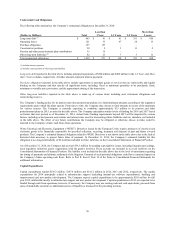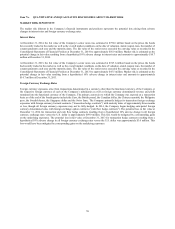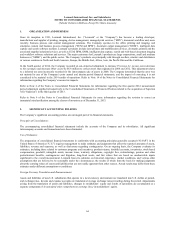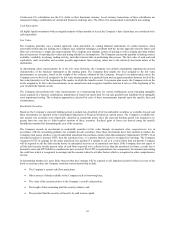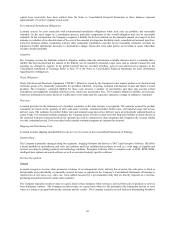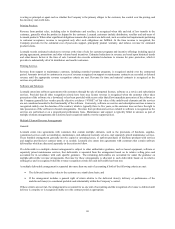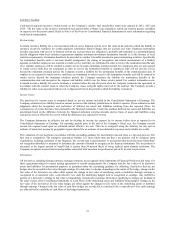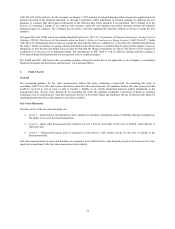Lexmark 2014 Annual Report Download - page 68
Download and view the complete annual report
Please find page 68 of the 2014 Lexmark annual report below. You can navigate through the pages in the report by either clicking on the pages listed below, or by using the keyword search tool below to find specific information within the annual report.Lexmark International, Inc. and Subsidiaries
NOTES TO CONSOLIDATED FINANCIAL STATEMENTS
(Tabular Dollars in Millions, Except Per Share Amounts)
1. ORGANIZATION AND BUSINESS
Since its inception in 1991, Lexmark International, Inc. (“Lexmark” or the “Company”) has become a leading developer,
manufacturer and supplier of printing, imaging, device management, managed print services (“MPS”), document workflow and, more
recently, business process and content management solutions. The Company operates in the office printing and imaging, and
enterprise content and business process management (“ECM and BPM”), document output management (“DOM”), intelligent data
capture and search software markets. Lexmark’s products include laser printers and multifunction devices, dot matrix printers and the
associated supplies/solutions/services, as well as ECM, BPM, DOM, intelligent data capture, search and web-based document imaging
and workflow software solutions and services. The major customers for Lexmark’s products are large corporations, small and medium
businesses (“SMBs”), and the public sector. The Company’s products are principally sold through resellers, retailers and distributors
in various countries in North and South America, Europe, the Middle East, Africa, Asia, the Pacific Rim and the Caribbean.
In the fourth quarter of 2014, the Company recorded an out-of-period adjustment to increase Provision for income taxes (decrease
to Net earnings) and decrease Other assets by $6.8 million to correct errors that originated in 2008 and 2012. This adjustment relates
to a deferred tax asset incorrectly recorded for the intercompany sale of assets in 2008. The Company determined that the error was
not material to any of the Company’s prior annual and interim period financial statements, and the impact of correcting it is not
considered to be material to the 2014 results of operations. Refer to Note 14 of the Notes to Consolidated Financial Statements for
information regarding the Company’s income tax impacts.
Refer to Note 4 of the Notes to Consolidated Financial Statements for information regarding the first quarter 2014 measurement
period adjustment applied retrospectively to the Consolidated Statements of Financial Position related to the acquisition of Saperion
AG (“Saperion”) in the third quarter of 2013.
Refer to Note 9 of the Notes to Consolidated Financial Statements for more information regarding the revision to correct an
immaterial misclassification among the classes of inventory as of December 31, 2013.
2. SIGNIFICANT ACCOUNTING POLICIES
The Company’s significant accounting policies are an integral part of its financial statements.
Principles of Consolidation:
The accompanying consolidated financial statements include the accounts of the Company and its subsidiaries. All significant
intercompany accounts and transactions have been eliminated.
Use of Estimates:
The preparation of consolidated financial statements in conformity with accounting principles generally accepted (“GAAP”) in the
United States of America (“U.S.”) requires management to make estimates and judgments that affect the reported amounts of assets,
liabilities, revenue and expenses, as well as disclosures regarding contingencies. On an ongoing basis, the Company evaluates its
estimates, including those related to customer programs and incentives, product returns, doubtful accounts, inventories, stock-based
compensation, goodwill, intangible assets, income taxes, warranty obligations, copyright fees, restructurings, pension and other
postretirement benefits, contingencies and litigation, long-lived assets, and fair values that are based on unobservable inputs
significant to the overall measurement. Lexmark bases its estimates on historical experience, market conditions, and various other
assumptions that are believed to be reasonable under the circumstances, the results of which form the basis for making judgments
about the carrying values of assets and liabilities that are not readily apparent from other sources. Actual results may differ from these
estimates under different assumptions or conditions.
Foreign Currency Translation and Remeasurement:
Assets and liabilities of non-U.S. subsidiaries that operate in a local currency environment are translated into U.S. dollars at period-
end exchange rates. Income and expense accounts are translated at average exchange rates prevailing during the period. Adjustments
arising from the translation of assets and liabilities, changes in stockholders’ equity and results of operations are accumulated as a
separate component of Accumulated other comprehensive earnings (loss) in stockholders’ equity.
64




